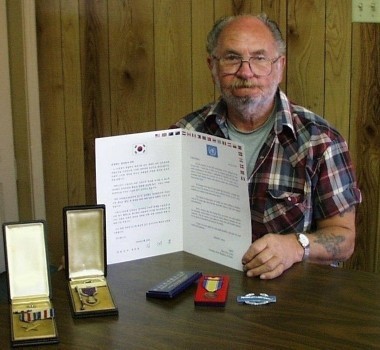Korean War Veteran
 |
Myron Stuffelbeam displays some of the medals awarded him during military
service.
|
By Dawn Bowen - Staff Writer Artesian Daily Press
Despite receiving a horrific injury to his face as the result of guerrilla
warfare, Myron Stuffelbeam continued fighting to defend the Pusan Perimeter
in Korea until snipers shot him in the shoulder and the right hand, spinning
his rifle out of his grip.
Stuffelbeam is one of many military veterans who received a Korean
War service medal and a letter of commendation from the president of the
Republic of Korea upon the 50th anniversary of the Korean War.
"We Koreans hold dear in our hearts the conviction, courage and spirit
of sacrifice shown to us by such selfless friends as you, who enabled us
to remain a free democratic nation," said the letter from Kim Dae-jung,
president of the Republic of Korea.
"Half a century after the Korean War, we honor you and reaffirm our
friendship, which helped to forge the blood alliance between our two countries."
Stuffelbeam enlisted in the U.S. Army in December 1947 at the age of
16, undergoing basic training at Ft. Knox, Ky.
He landed in Korea in May 1948 at Inchon, Korea, where he served in
an around-the-clock guard company that protected the boat docks at Inchon,
a frozen food plant at the end of the Hawn River Bridge, an Army prison
and a quartermaster depot in Seoul, a 13-mile ammunition site close to
Kaesong and a railroad fuel depot outside of Seoul.
While serving in the guard company, Stuffelbeam was in the honor guard
for 20 soldiers who were killed in a train wreck.
Later, in May 1949, Stuffelbeam went to Scofield barracks in Hawaii
where he trained in advanced combat until July 1950. He then returned to
Korea on the General Mann troop ship, landing at Pusan on July 29.
A member of the U.S. Army's 5th Infantry, he was immediately sent to
defend what later became known as the Pusan Perimeter at the southeastern
tip of South Korea.
During an intense, hostile attack on the 5th Infantry's position near
Tae Jong-ni on Aug. 13, 1950, only 15 days after Stuffelbeam returned to
Korea, he was seriously wounded in the face by the explosion of a grenade
that was thrown by a guerrilla into a tree above the position of Stuffelbeam
and 11 other infantrymen.
"After I got hit in the face and eyes, that's when I got up and started
shooting," Stuffelbeam said.
Stuffelbeam recalled he loaded two additional clips into his weapon
during the time he was able to return fire, until he was shot twice and
unable to hold his weapon and fell backwards into a foxhole.
Stuffelbeam said he doesn't really remember what happened next, but
believes he was put onto a stretcher and carried from the area to a nearby
aid station and later flown to a field hospital by helicopter. He has no
idea what became of the others in his company who were also wounded.
His gallant actions during the incident were rewarded with a Silver
Service Star.
"Despite his painful wound, he continued to fire his rifle at the fanatic
attackers until he was wounded in both hands and unable to hold his weapon,"
said a general order sent to Stuffelbeam on Nov. 3, 1950, accompanying
the Silver Service Star he was awarded for gallantry in action.
"By his selfless devotion to duty, he assisted materially in repelling
the hostile forces and contributed greatly to the esprit of his unit.
"Private First Class Stuffelbeam's courageous action reflects great
credit upon himself and the United States Army," the general order said.
Stuffelbeam was also awarded a Bronze Service Star, a Combat Infantry
Badge, a United Nations medal, an Army of Occupation medal for his previous
service in Japan and a Purple Heart for military merit.
The injured soldier was eventually moved from the field hospital in
Korea to Brook Army Hospital in San Antonio, where as a 19-year-old veteran,
he underwent extensive reconstructive surgery and speech therapy.
His injuries were severe, especially to his mouth and chin where the
grenade explosion had rendered the most damage, leaving him disfigured.
The hospital stay would last more than two years.
"It sounds like a long time, but when I left there in 1953, there were
people that had been there since the early 1940's," Stuffelbeam said.
The doctors rebuilt his mouth and lips, using skin taken from his shoulder.
Speech therapists helped him with the pronunciation of various sounds and
letters.
A strikingly handsome 19-year-old man, Stuffelbeam could have easily
become depressed during the reconstruction of his face, but instead he
looked around and counted his blessings.
"That's when your sense of humor had better show up," he said, adding,
"That's when you look around you and see people that are much worse."
Those who now know him best probably notice Stuffelbeam's scars from
the reconstructive surgery that are slightly visible beneath his beard.
His speech, however, is remarkably clear and his attitude and outlook on
life show no remaining scars from the severe combat wound.
Stuffelbeam was discharged from the hospital and from the Army in May
1953. He returned to Iowa, where he was born and raised, and began learning
to work on electric motors.
He married his wife, Patricia, in 1953, and the couple had five children
of their own, adopted two boys and raised a niece and nephew for seven
years. Patricia Stuffelbeam passed away in June 1989.
The Stuffelbeams came to New Mexico in 1961, "because of the weather."
He worked for Kyle Electric for well over 20 years and is "mostly retired"
now, working at Kyle on occasion.
More Artesians who are war veterans were featured in an article in the
December 10, 2000 issue of the Daily Press. This article also appears in
the Archives section of this website. |
